towing Peugeot Boxer 2016 Owner's Manual
[x] Cancel search | Manufacturer: PEUGEOT, Model Year: 2016, Model line: Boxer, Model: Peugeot Boxer 2016Pages: 292, PDF Size: 10.07 MB
Page 5 of 292
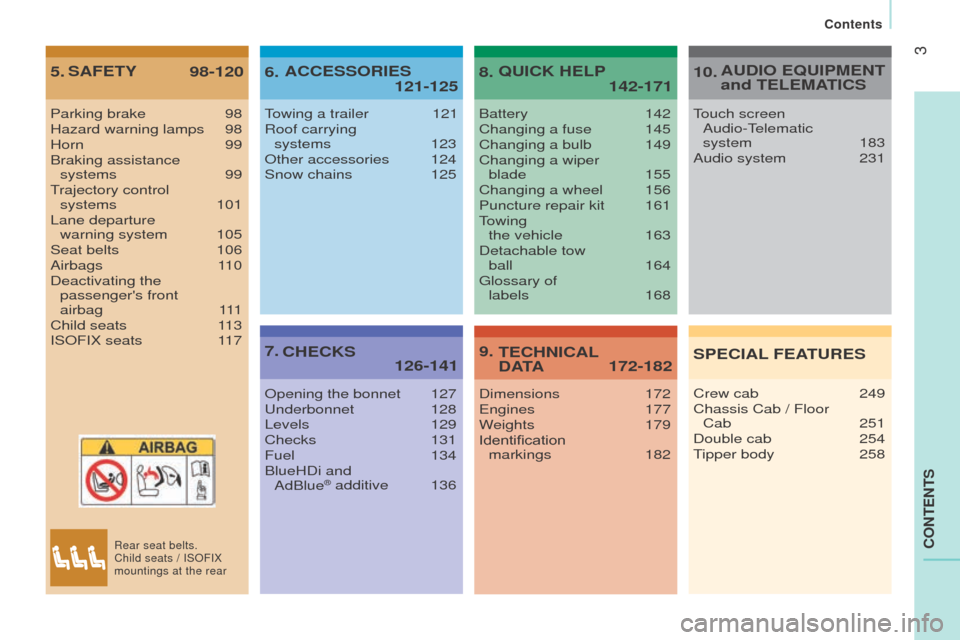
3
boxer_en_Chap00a_Sommaire_ed01-2015
cont
Ent
S
5. 98-120
SAFE t Y
6.
121-125
A
cc ESS or IES
7.
126-141c
HE c KS8.
142-171
Q
u I c K HELP
9.
172-182t E c H n I c AL dA
t A
Parking brake 98
Hazard warning lamps 98
Horn
99
Braking assistance systems
99trajectory control
systems
101
Lane departure
warning system
105
Seat belts
106
Airbags
110
Deactivating the passenger's front
airbag
111
Child seats
1
13
ISOFIX seats
1
17towing a trailer 121
Roof carrying
systems
123
Other accessories
124
Snow chains
125
Opening the bonnet
127u
nderbonnet 128
Levels
129
Checks
131
Fuel
134
BlueHDi and AdBlue
® additive 136 Battery
142
Changing a fuse
145
Changing a bulb
149
Changing a wiper
blade
155
Changing a wheel
156
Puncture repair kit
161towing
the vehicle
163
Detachable tow
ball 164
g
lossary of
labels
168
Dimensions
172
e
ngines 177
Weights 179
Identification markings 182
10.
A ud I o EQ u IPME nt
and t ELEMAt I c S
SPE
c IAL FEA
tur
ES
touch screen
Audio- telematic
system
183
Audio system
231
Crew cab
249
Chassis Cab / Floor
Cab
251
Double cab
254tipper body
258
Rear seat belts.
Child seats / ISOFIX
mountings at the rear
Contents
Page 8 of 292
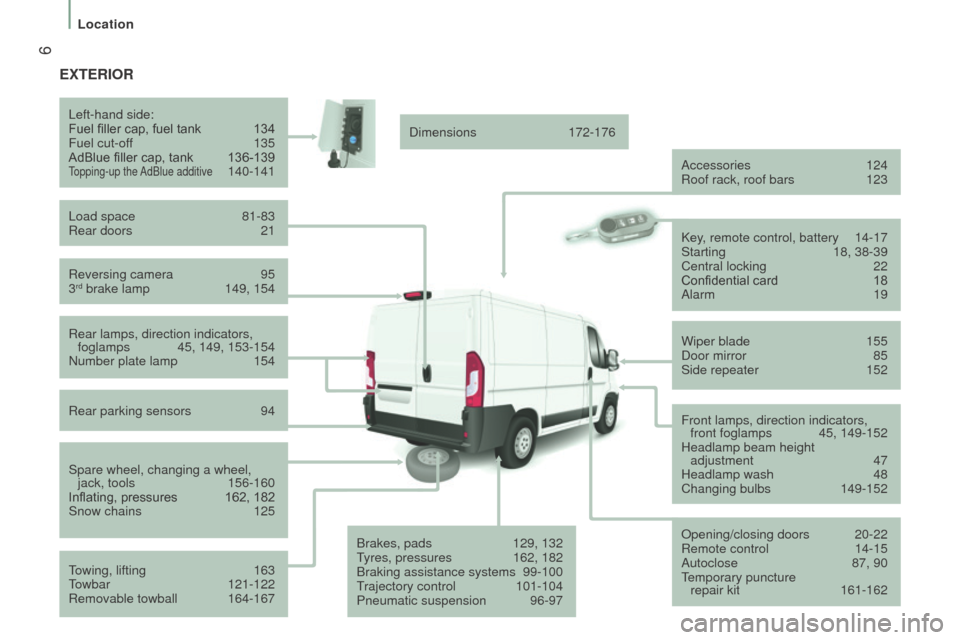
6
boxer_en_Chap01_Vue-ensemble_ed01-2015
ExtErIor
Reversing camera 95
3rd brake lamp 149, 154
Left-hand side:
Fuel filler cap, fuel tank
134
Fuel cut-of
f
135
AdBlue filler cap, tank
136-139topping-up the
AdBlue additive 140-141
Load space
81-83
Rear doors
21
Rear lamps, direction indicators, foglamps
45, 149, 153-154
Number plate lamp
154
Rear parking sensors
94
Spare wheel, changing a wheel, jack, tools
156-160
Inflating, pressures
162, 182
Snow chains
125
towing, lifting
163towbar
121-122
Removable towball
164-167 Dimensions
172-176
Accessories
124
Roof rack, roof bars 123
Brakes, pads
129, 132tyres, pressures
162, 182
Braking assistance systems
99-100trajectory control
101-104
Pneumatic suspension
96-97Key
, remote control, battery
14-17
Starting
18, 38-39
Central locking
22
Confidential card
18
Alarm
19
Wiper blade
155
Door mirror
85
Side repeater
152
Opening/closing doors
20-22
Remote control
14-15
Autoclose
87, 90temporary puncture repair kit
161-162
Front lamps, direction indicators,
front foglamps
45, 149-152
Headlamp beam height adjustment
47
Headlamp wash
48
Changing bulbs
149-152
Location
Page 9 of 292

7
boxer_en_Chap01_Vue-ensemble_ed01-2015
Seat belts 106-108
Airbags 110-112
Deactivating the passenger's front airbag 111, 11 4
Parking brake, handbrake
98
Front seats, adjustments
71-72
Seat with variable damping
72
2-seat bench
73 Child seats
1
13-116, 119-120
12 volt socket,
u
SB port
79, 81-82 Battery (+), charging,
starting 142-144
e
arth point (-)
128, 142
Fuses in the right hand door pillar 145, 147
IntErIor
Seats / rear bench
seats 74-75
Rear heating / air conditioning
65-66
Sliding side door
20
Folding foot board
84
Sliding side windows
83 Rear view mirror
85
Lane departure warning system
105
Cab courtesy lamp
80, 152
Changing a courtesy lamp bulb
149, 152
ISOFIX mountings 117-118
tools, jack
76, 156
Accessories
124
Load space
81-82
●
stowing rings,
● load retainer ,
●
interior roof box,
●
side trims,
●
12 volt socket,
●
courtesy lamp,
torch
83
1
OVeRVIeW
Location
Page 21 of 292
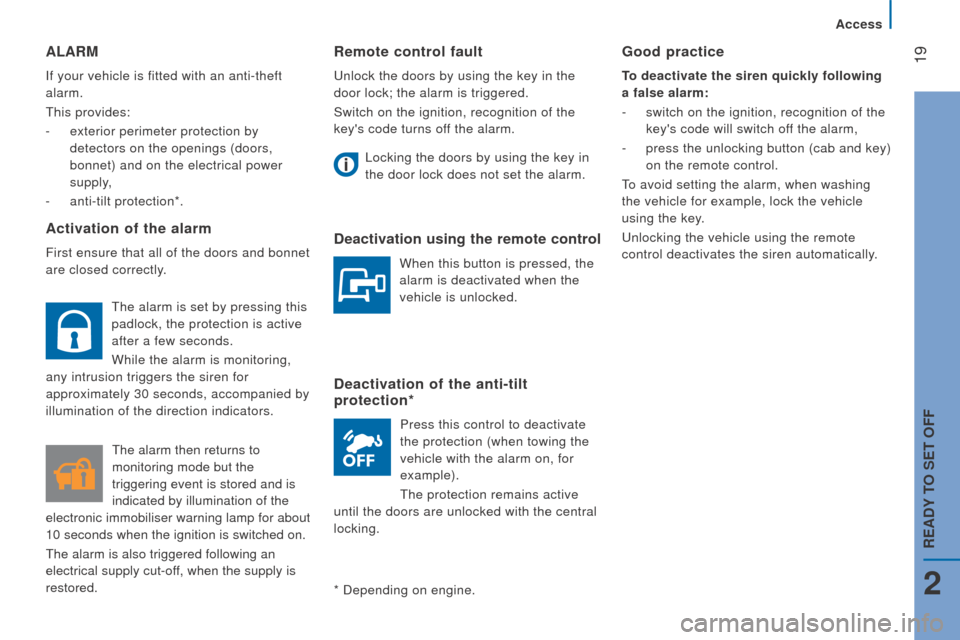
19
boxer_en_Chap02_Pret-a-Partir_ed01-2015
remote control fault
unlock the doors by using the key in the
door lock; the alarm is triggered.
Switch on the ignition, recognition of the
key's code turns off the alarm.
Locking the doors by using the key in
the door lock does not set the alarm.
deactivation using the remote control
When this button is pressed, the
alarm is deactivated when the
vehicle is unlocked.
deactivation of the anti-tilt
protection*
Press this control to deactivate
the protection (when towing the
vehicle with the alarm on, for
example).
t
he protection remains active
until the doors are unlocked with the central
locking.
ALArM
If your vehicle is fitted with an anti-theft
alarm.
t
his provides:
-
exterior perimeter protection by
detectors on the openings (doors,
bonnet) and on the electrical power
supply,
-
anti-tilt protection*.
Activation of the alarm
First ensure that all of the doors and bonnet
are closed correctly.
*
Depending on engine.
Good practice
to deactivate the siren quickly following
a false alarm:
-
switch on the ignition, recognition of the
key's code will switch off the alarm,
-
press the unlocking button (cab and key)
on the remote control.
to avoid setting the alarm, when washing
the vehicle for example, lock the vehicle
using the key.
u
nlocking the vehicle using the remote
control deactivates the siren automatically.
t
he alarm is set by pressing this
padlock, the protection is active
after a few seconds.
While the alarm is monitoring,
any intrusion triggers the siren for
approximately 30 seconds, accompanied by
illumination of the direction indicators.
t
he alarm then returns to
monitoring mode but the
triggering event is stored and is
indicated by illumination of the
electronic immobiliser warning lamp for about
10
seconds when the ignition is switched on.
t
he alarm is also triggered following an
electrical supply cut-off, when the supply is
restored.
2
Access
rEAdY to SEt oFF
Page 83 of 292
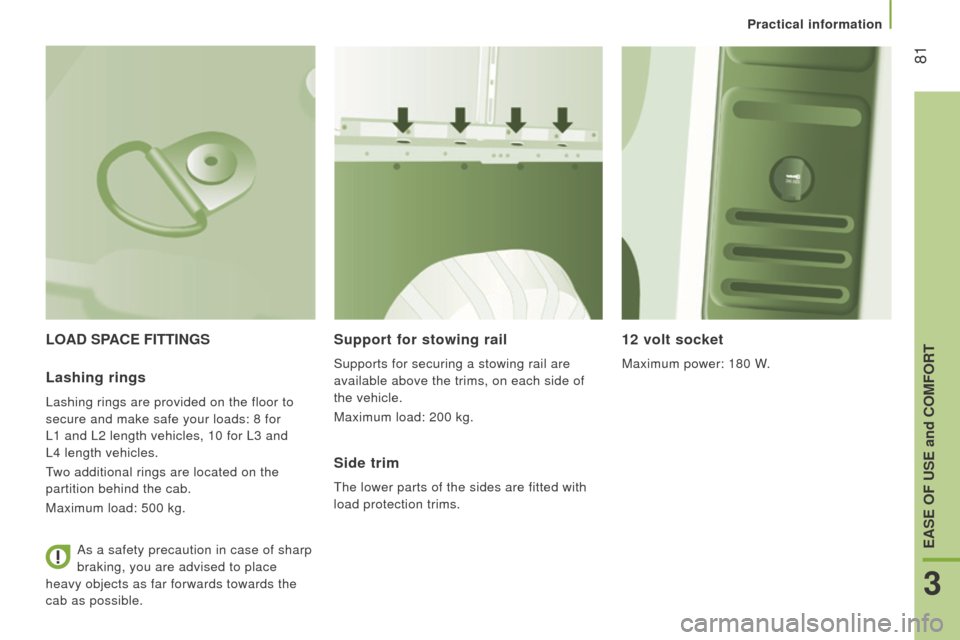
81
boxer_en_Chap03_ergo-et-confort_ed01-2015
LoAd SPAcE FIttInGSSupport for stowing rail
Supports for securing a stowing rail are
available above the trims, on each side of
the vehicle.
Maximum load: 200 kg.
12 volt socket
Maximum power: 180 W.Lashing rings
Lashing rings are provided on the floor to
secure and make safe your loads: 8 for
L1 and L2 length vehicles, 10 for L3 and
L4 length vehicles.
two additional rings are located on the
partition behind the cab.
Maximum load: 500 kg.
Side trim
the lower parts of the sides are fitted with
load protection trims.
As a safety precaution in case of sharp
braking, you are advised to place
heavy objects as far forwards towards the
cab as possible.
Practical information
3
EASE oF uSE and coMFort
Page 124 of 292

122
boxer_en_Chap06_Accessoires_ed01-2015
driving advice
distribution of loads: distribute the load in
the trailer so that the heaviest objects are as
close as possible to the axle and the nose
weight is close to the maximum authorised
without, however, exceeding it.
c
ooling: towing a trailer on a slope
increases the coolant temperature.
As the fan is electrically controlled, its
cooling capacity is not dependent on the
engine speed.
On the contrary, use a high gear to lower the
engine speed and reduce your speed.
In all cases, pay attention to the coolant
temperature.
tyres:
check the tyre pressures of the
towing vehicle and of the trailer, observing
the recommended pressures.
Fitting a towbar
We recommend the use of genuine
P euge O t
towbars and their harnesses,
which have been tested and approved from
the design stage of your vehicle and that
the fitting of this equipment is entrusted to a
P
euge O t
dealer
.
t
hese genuine towbars are compatible with
the operation of the rear parking sensors
and the reversing camera, if fitted to your
vehicle.
If this equipment is not fitted by a P
euge O t
dealer
, it must be fitted in line with the
manufacturer's instructions.
Good practice
If the coolant temperature
warning lamp comes on, stop the
vehicle and switch off the engine
as soon as possible.
Refer to the "Checks - Levels and
checks" section.
Brakes: towing increases the braking
distance. Drive at a moderate speed,
change down early and brake gradually. Side wind: sensitivity to side wind is
increased. Drive smoothly and at a
moderate speed. ABS: the system only controls the vehicle,
not the trailer.
r
ear parking sensors: the system is
deactivated while the vehicle is towing with a
genuine P
euge O t
towbar fitted.
Refer to the "
t
echnical data -
Identification markings" section.
transport solutions
Page 158 of 292
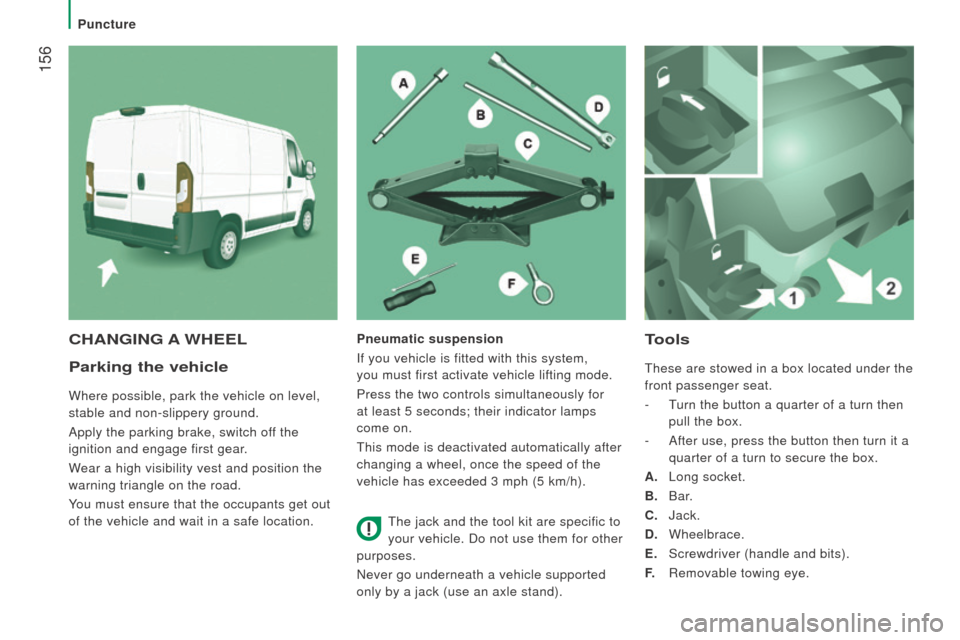
156
boxer_en_Chap08_Aide-Rapide_ed01-2015
Parking the vehicle
Where possible, park the vehicle on level,
stable and non-slippery ground.
Apply the parking brake, switch off the
ignition and engage first gear.
Wear a high visibility vest and position the
warning triangle on the road.
You must ensure that the occupants get out
of the vehicle and wait in a safe location.
tools
these are stowed in a box located under the
front passenger seat.
-
t
urn the button a quarter of a turn then
pull the box.
-
After use, press the button then turn it a
quarter of a turn to secure the box.
A.
Long socket.
B.
Bar.
c
. Jack.
d
. Wheelbrace.
E.
Screwdriver (handle and bits).
F.
Removable towing eye.
cHAnGInG A WHEELPneumatic suspension
If you vehicle is fitted with this system,
you must first activate vehicle lifting mode.
Press the two controls simultaneously for
at least 5 seconds; their indicator lamps
come on.
t
his mode is deactivated automatically after
changing a wheel, once the speed of the
vehicle has exceeded 3 mph (5 km/h).
t
he jack and the tool kit are specific to
your vehicle. Do not use them for other
purposes.
Never go underneath a vehicle supported
only by a jack (use an axle stand).
Puncture
Page 161 of 292
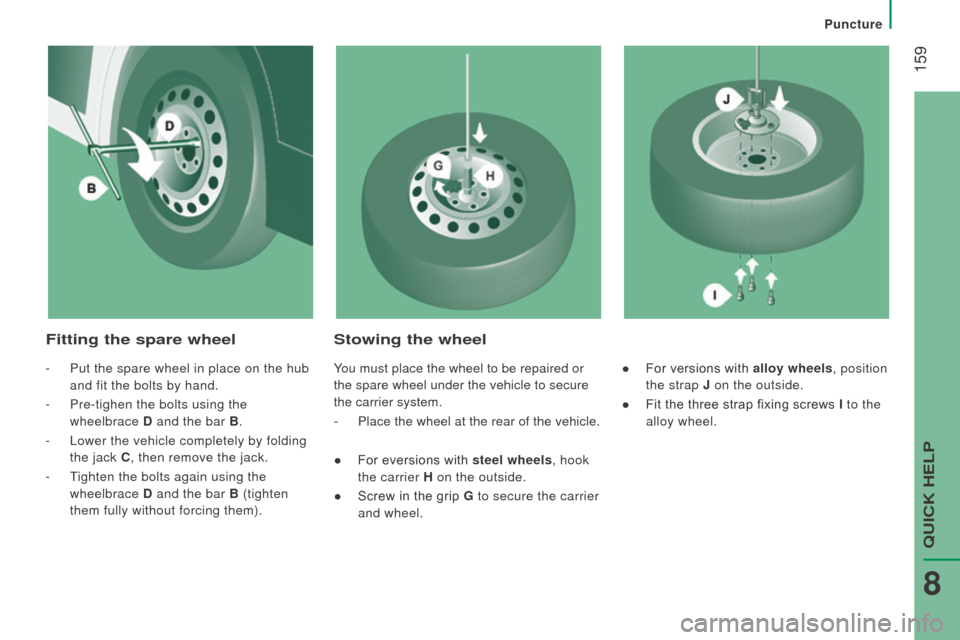
159
boxer_en_Chap08_Aide-Rapide_ed01-2015
Fitting the spare wheelStowing the wheel
- Put the spare wheel in place on the hub
and fit the bolts by hand.
-
Pre-tighen the bolts using the
wheelbrace
d and the bar
B.
-
Lower the vehicle completely by folding
the jack
c
, then remove the jack.
-
t
ighten the bolts again using the
wheelbrace
d and the bar
B (tighten
them fully without forcing them). You must place the wheel to be repaired or
the spare wheel under the vehicle to secure
the carrier system.
-
Place the wheel at the rear of the vehicle.
●
For eversions with
steel wheels, hook
the carrier H on the outside.
●
Screw in the grip
G to secure the carrier
and wheel. ●
For versions with alloy wheels, position
the strap j
on the outside.
●
Fit the three strap fixing screws
I to the
alloy wheel.
Puncture
QuICK HeLP
8
Page 165 of 292

163
boxer_en_Chap08_Aide-Rapide_ed01-2015
toWI n G
t
owing the vehicle
the removable towing eye is located in the
tool box under the front passenger seat.
u
nclip the cover using a flat tool.
Screw the removable towing eye in fully.
Attach the approved towing arm to to the
removable towing eye.
Place the gear lever in neutral.
towing another
vehicle
the fixed towing eye is located on the right
below the bumper .
Attach the approved towing arm to the fixed
eye.
Failure to observe this requirement
may result in damage to certain braking
components and the lack of some braking
assistance systems when the engine is
re-started.
General recommendations
Observe the legislation in force in your
country.
e
nsure that the weight of the towing vehicle
is higher than that of the towed vehicle.
t
he driver must remain at the wheel of the
towed vehicle and must have a valid driving
licence.
When towing a vehicle with all four wheels
on the ground, always use an approved
towing arm; rope and straps are prohibited.
t
he towing vehicle must move off gently.
When towing a vehicle with the engine off,
there is no longer any power assistance for
braking or steering.
In the following cases, you must always call
on a professional recovery service:
-
vehicle broken down on a motorway or
fast road,
-
four-wheel drive vehicle,
-
when it is not possible to put the
gearbox into neutral, unlock the
steering, or release the parking brake,
-
towing with only two wheels on the
ground,
-
where there is no approved towing arm
available...
Being towed or towing
QuICK HeLP
8
Page 166 of 292

164
boxer_en_Chap08_Aide-Rapide_ed01-2015
toWBA r WI t H Q u I c KLY
d E t
A
c HABLE to WBALL
Presentation
this towball can be fitted and removed
quickly and easily without the use of tools. For information on the maximum
trailer weight and the recommended
nose weight, refer to the " t
echnical data -
Weights" section.
For information on safely towing a trailer,
refer to the "Accessories -
towing a trailer"
section.
1.
Carrier.
2.
Connector socket.
3.
Safety eye.
4.
Detachable towball.
5.
Locking / unlocking wheel.
6.
Key lock.
7.
Key reference label. A.
Locked
position; the locking wheel is in
contact with towball (no gap).
B.
u
nlocked position; the locking wheel
and towball are no longer in contact
(gap of about 5 mm). Before each use
Check that the towball is correctly
locked and verify the following points:
- the green mark on the locking wheel
is in line with the green mark on the
towball,
-
the locking wheel is in contact with the
towball,
-
the key lock is on and the key removed;
the locking wheel can no longer be
operated,
-
the towball must no longer move at all in
its carrier; try to shake it by hand.
d
uring use
Never unlock the device when a trailer or
load carrier is fitted to the towball.
Never exceed the maximum authorised
weight for the vehicle (the
g ross Vehicle
Weight -
g VW), the trailer, or the sum of the
two (the
g ross
train W
eight - gt W).
Observe the legislation in force in the
country in which you are driving. After use
For journeys made without a trailer or load
carrier, the towball must be removed and
the blanking plug inserted in the carrier.
t
his
measure applies particularly if the towball
could hinder visibility of the number plate or
lighting.
transport solutions